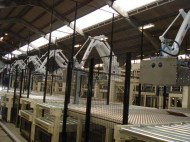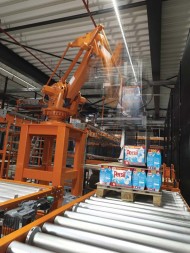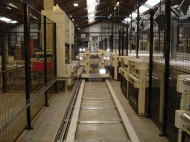 CSi Industries are worldwide specialists in the supply of both pallet conveyors for warehousing and logistics. They also provide fully integrated material handling systems to handle FMCG products from single pack to pallet. CSi have installed these systems for blue chip clients throughout the world. As a turnkey supplier CSi provide a complete package from initial consultancy and design to production, assembly, delivery, installation and commissioning. During execution CSi support all their projects with experienced project management teams and system engineers, and provide all the relevant services required throughout the life cycle of the installation.
CSi Industries are worldwide specialists in the supply of both pallet conveyors for warehousing and logistics. They also provide fully integrated material handling systems to handle FMCG products from single pack to pallet. CSi have installed these systems for blue chip clients throughout the world. As a turnkey supplier CSi provide a complete package from initial consultancy and design to production, assembly, delivery, installation and commissioning. During execution CSi support all their projects with experienced project management teams and system engineers, and provide all the relevant services required throughout the life cycle of the installation.
CSi maintain a strong market position with a spread of customers including manufacturers of fast moving consumer goods, distributors and the packaging industry. They have built this position due to the reliability of their products and services, their ability to design bespoke solutions, their innovation and expertise, their passion and drive and their total commitment to customer satisfaction. Phil Griffiths, CSi Industries’ UK General Manager, spoke to Warehouse & Logistics News.
WLN – First of all, Phil, what does your role as UK General Manager involve day to day?
I am responsible for sales and the overall running of the office. We need to achieve a target number of projects per year: some 70% of our effort is driven to achieving sales targets through marketing and cold calling specific customers.
WLN – How big is CSi? What kind of marketing do you do?
CSi is a relatively large company, with a turnover of £50-60m and budgets allocated around the world for telemarketing, advertising, exhibitions and online activity.
WLN – Are you personally involved with clients?
I’m personally involved, together with our engineers, in creating solutions and presenting them to customers and achieving customers’ requirements in a timely fashion.
WLN – How long have you been at CSi? What were you doing before?
 I was involved with the original business from 1990/91, when it was part of Stork Conveyors. The management bought the business in 2001, and approached me in 2004 to come back to the newly renamed CSi. I was originally an engineer, then moved into project management, and from there into sales and marketing.
I was involved with the original business from 1990/91, when it was part of Stork Conveyors. The management bought the business in 2001, and approached me in 2004 to come back to the newly renamed CSi. I was originally an engineer, then moved into project management, and from there into sales and marketing.
WLN – How is CSi set up to meet the needs of customers in the UK warehouse and logistics sector for pallet handling systems? Do you have a dedicated customer team serving this sector?
Our UK sales people take enquiries from all industry sectors and cover the UK and Ireland. We have a UK Sales Manager, Peter Blinkhorn, a UK Service Manager, Rob Pedlar, and office support in Chester. In Holland we have sales support and project teams split by industry sector. We cover such key client areas as tobacco, a major area for us, and warehousing and logistics. We’re also involved with snacks, confectionery, dairy and juices, personal and home care, and occasionally automotive. Typically we take on a project and get sales engineering support from Holland. A lot of our business is FMCG: we are the biggest palletising company in Europe, if not the world, and our equipment moves more pallets in Europe than anyone else. We’re split 75:25 to FMCG, but have some great ‘w&l’ clients.
WLN – Looking at the UK marketplace, what are the main issues affecting the adoption of pallet conveyors and pallet handling systems?
Pallet handling means moving pallets, and making a choice between conveyors or fork lift trucks. In large operations people are interested in automating the end of their production lines as much as possible, and if you put in an automated warehouse, then there’s no point in forklifts. Companies invest in moving pallets from a to b, but in the main these investments are part of expenditure on an overall system.
If you don’t take in the total product flow, you’ve only covered two thirds of the process. You can put in automated palletisers and a high bay warehouse and then extend, but I don’t recall many recent projects that have done so. Many projects have end of line palletisers feeding fork lifts, but as they get faster, they automate and do away with them.
WLN – What’s the tipping point where automation takes the place of fork lifts?
Every site is different. If you have plenty of room, fork lifts can continue to handle pallets safely. But if FLT movements are getting congested, then you may need to think about automating. The risk of accidents and product damage becomes much higher with more trucks working. For every pallet movement in and out of the warehouse, there’s a cost: when the figure becomes unreasonable, it’s time for automation.
WLN – What effect has the recent economic gloom had on installations?
Many projects have been postponed, and large companies have delayed as long as possible, but even so, these large projects still have to go forward as part of bigger schemes, and we’re currently working flat out in the UK.
WLN – When was CSi founded?
CSi has been in business over 45 years, starting life as a small conveyor supplier with its roots in Rotterdam. The company became part of the Swedish PLM-group in the 1970s. During the 1980s it became an independent company, until it was bought by Stork. After several attempts to restructure the Stork Group, there was an MBO, and from 2001 onwards CSi became an independent company again. In 2003 Ridder Packaging Systems was purchased and merged into CSi, whilst at the same time the brand name of Ivanhoe was launched, under which standardised palletising solutions were sold. 2005 saw the creation of a new production facility in Romania: CSi Romania, manufacturing logistic systems, and AlphaLas, making equipment for third parties.
WLN – Who owns CSi now?
The present owners are Jan de Bruijn, Kees Oosting and George Gierveld, who are actively managing the successful development of the company. Many of CSi’s employees also have shares, and will profit as CSi continues to grow.
WLN – What does CSi stand for?
The ‘CS’ part stands for Conveyor Systems, and the CS logo has been part of our heritage for decades. We’ve modernised it and added the ‘i’ in recent years. We now also have a range of products which start with the letter ‘i’ – I-Pal robot palletisers for leasing, i-Pack bespoke robot palletisers, i-Veyor modular pallet conveyors and i-Lease financial services.
WLN – Where is CSI’s world headquarters?
 Our head office is in the Netherlands, and we have a significant production facility in Romania to ensure the lowest possible production cost whilst maintaining our high quality standards. We have 250 people in Holland and 200 in Romania.
Our head office is in the Netherlands, and we have a significant production facility in Romania to ensure the lowest possible production cost whilst maintaining our high quality standards. We have 250 people in Holland and 200 in Romania.
WLN – Where do you develop your pallet conveyor technology?
All our engineering and design is done in Raamsdonksveer, Holland. We build specials in Holland, and all standard modular kit in Romania.
WLN – How do you supply your products around the world – do you have local offices or agents?
CSi is represented in many countries across the world either through our own sales offices or through local partner networks. We are strong at developing relationships with our global customers by means of professional account management. In this way we can act locally, whilst still being a global player. This approach strengthens our relationships with our customers and at the same time concentrates our knowledge and experience.
WLN – How big are you in the UK?
We average £8m-£12m per year depending on the number of projects. We have a backlog of projects coming through in 2011.
WLN – Where is your UK office?
Our main office has been in Chester since 2005. We were previously in Camberley. We do no manufacturing in the UK, but have a long tradition of links with the big UK and European FMCG manufacturers who use our conveyors and appreciate our strength in consistent quality and robustness.
WLN – Can you talk us through the different technologies you offer?
We start with bespoke conveyors, and then a full range of standard products and conveyor modules, completed with standard or bespoke machines or robotic palletisers, backed up by expertise in integration. Also, if a conveyor is blocking a factory, we come up with something else instead. We even use bought in AGV (Automated guided vehicle) systems if appropriate, rather than fork lifts.
WLN – Would you say you are against fork lift trucks in principle?
Far from it! Most pallet handling is still done best by fork lifts, providing you can meet the capacity safely and economically. It comes down to economics.
WLN – What weight and dimensions of pallets and other items can your conveyors move?
The maximum pallet weight on our standard conveyors is 1500kg, but we can supply tailored conveyors up to 2000kg. We handle all types of pallet – UK, Euro, US and bespoke. Sometimes you can’t handle pallets on standard conveyors, for instance for tea sacks we use flat slat conveyors which can handle the inconsistent and poor quality pallets that these come with.
WLN – What kind of throughput are we talking about?
The slowest part of any conveyor is where there’s a change in direction. One instance is a turntable, or a right-angled transfer, which takes 180 pallets per hour. In one project we have been running 600 pallets per hour through multiple feeds and discharges to and from a high bay warehouse, with different layers of conveyors.
WLN – Are pallet conveyors always the right answer for large-scale pallet handling? What are the other alternatives for people to consider? Do you supply them as well?
Not always. AGV’s are a good alternative when conveyors prevent access to other areas, for example shuttle cars can work at slow speeds, together with fork lift trucks. If there are fixed routes of working we use shuttle cars: if the route varies, AGVs. We buy in the AGVs and shuttle cars and integrate them into our solutions.
WLN – Do you offer a consultancy service for companies who are thinking of moving to automated pallet handling, but aren’t quite sure of what the best solution is?
 We do, and treat some of our sales work as free consultancy. When the client data is poor, we volunteer to do the surveying and so on, to get enough data to start the project. If the client is looking at internal logistics, they will call us in: some customers also look to us as strategic partners, but 99% of our consultancy is site-focused.
We do, and treat some of our sales work as free consultancy. When the client data is poor, we volunteer to do the surveying and so on, to get enough data to start the project. If the client is looking at internal logistics, they will call us in: some customers also look to us as strategic partners, but 99% of our consultancy is site-focused.
WLN – How does your pallet handing equipment and your approach differ from other suppliers?
Our solutions are creative, and our strapline is ‘creating solutions together.’ Most of our conveyors are part of a bigger solution. We have a big enough customer base to give people confidence in us, and it rubs off. The kit is different because of the uptime it delivers – we sell system availability, and guarantee on most systems technological availability of 99.7%, which leads the industry. We will happily introduce potential clients to reference customers.
WLN – Which have been your landmark installations?
P&G is a major reference customer throughout Europe, and our pallet handling systems are in a large number of their high bay distribution warehouses. We also provide pallet handling for Mars Confectionery. Weetabix is another major company we have provided with various systems over the years, including recently. And, in the same sector, Pepsico (Walkers) is worth mentioning.
WLN – Are your systems modular? How much can they be tailored to suit the individual operation? Can they be extended as needs changed? Can they be integrated with other suppliers’ equipment, to replace worn out units?
Our systems are very modular, and very standardised. One of the key ranges is the i-Veyor, a standard range of modular conveying systems. We can also offer bespoke versions but most are standard. We design them for ease of manufacture and installation, very eco-friendly and as green as they can be in a not so green world, and can be extended as needs change, with new units and drives.
WLN – What is the typical lifecycle of your equipment? How long does it take to see a return?
20-25 year lifecycles for pallet handling systems is not uncommon. Conveyors will easily run for 25 years, but drives and controls may need upgrading as process technology improves. The figures we have for ROI show the average return on big projects is two years: most pure pallet handling solutions can achieve payback in 12 months, by immediately saving the cost of fork lifts and drivers.
WLN – Do you publish case studies?
Yes, we do – see opposite page
WLN – How quickly can you quote for a project? How long does installation take?
We’re very quick: we have a standard calculation model, and can do the basic quote within five working days, depending what the customer is after – it may be enough for them to decide the order of cost and think about taking the project to the next stage.
A full calculation needs a site survey, auto CAD drawings, systems calculations and takes longer, from two weeks to a month. From order to go live on site for a £2m palletiser could be six months. We specify the civils – steelwork, platforms and so on – and are able to integrate them, but do not do them ourselves.
WLN – What kind of support do you offer?
 Our service side is called LCSi – Lifetime Cycle Service. It’s provided from Holland and we have 50 people in the service department. In the UK we work with local service partners. The UK side is headed up by Rob Pedlar. We offer breakdown cover, remote monitoring, a 24 hour help desk, 24 hour call outs and performance contracts where the customer pays us to maintain efficiency at 99.7% – not all customers have the same commitment to maintenance, but if they need a high level, this is ideal.
Our service side is called LCSi – Lifetime Cycle Service. It’s provided from Holland and we have 50 people in the service department. In the UK we work with local service partners. The UK side is headed up by Rob Pedlar. We offer breakdown cover, remote monitoring, a 24 hour help desk, 24 hour call outs and performance contracts where the customer pays us to maintain efficiency at 99.7% – not all customers have the same commitment to maintenance, but if they need a high level, this is ideal.
WLN – What about training? Do you provide on-site maintenance staff?
We provide training for operators, fitters and maintenance people around the world, and also health and safety audits on the kit. Most customers are ahead of the game, but some need us to go in and check that guarding, access, locking and so on are still up to spec. We can offer 24 modem contact into our system and look at how the machine is running and communicate with the engineer on site. People can also phone our help desk even if they don’t have a service contract: if people do have one, the status of your system’s latest software will be available to our engineers day or night.
WLN – What do you see as the future areas for development in intelligent pallet handling technology?
In conveyors, we will be working on developing partnerships with other vendors to support our systems, for example pallet wrappers, AGVs and other ancillary systems. We will also be working on increasing the level of standardisation and modularity, to deliver cheaper, better and higher volume systems.
WLN – Finally, where do you see CSi International and your pallet handling systems going from here?
We intend to build on our already strong customer base. Focusing on the warehousing and logistics sector, an important aim for us is the further development of our warehousing and distribution solutions. We are developing a new range of pallet and case handling equipment purely for this part of the market. Warehouse and distribution systems require a lighter touch, while maintaining the CSi logo’s promise of robustness and maximum system availability. We look forward to letting your readers know more about these products in due course.
CSi UK
Tel: 01244 341298




Comments are closed.